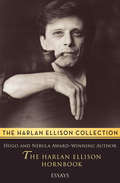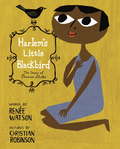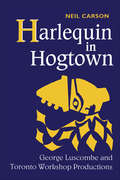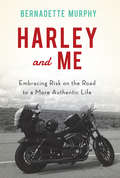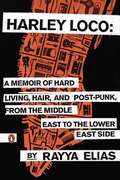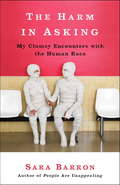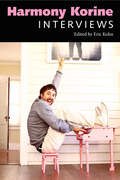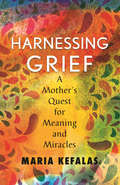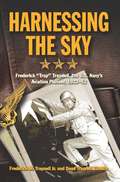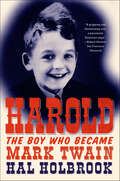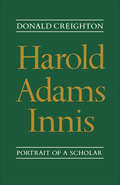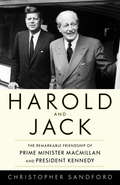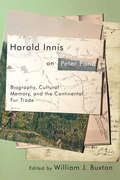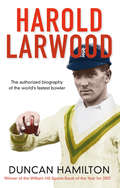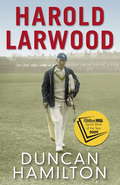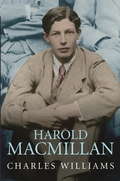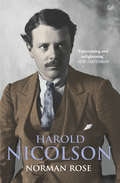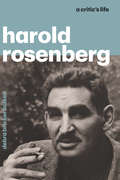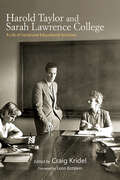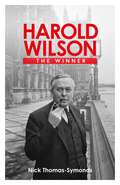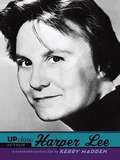- Table View
- List View
The Harlan Ellison Hornbook: Essays
by Harlan EllisonA major collection of Harlan Ellison's incomparable, troublemaking, uncompromising, confrontational essays and newspaper columns, The Harlan Ellison Hornbook mines deep into the author's colorful past. Failed love affairs, departed pets, a defense of comic books--in lesser hands, these subjects would be pabulum or treacle. When Harlan Ellison is behind the typewriter, the mundane becomes an all-out intellectual brawl. Emotionally moving and verbally stimulating, these columns cannot be missed, especially Ellison's article on controversial comedian Lenny Bruce or the chilling account of the author's trip to visit a death row inmate in San Quentin State Prison.
Harlan Hubbard: Life and Work
by Wendell BerryLectures by distinguished writer, environmentalist and sustainable agriculturalist Berry (U. of Kentucky) on the life and work of Harlan Hubbard, an earlier Kentucky original--writer, painter, and advocate (and prototype) of rural self-sufficiency.
Harlem's Little Blackbird: The Story of Florence Mills
by Renee Watson Christian RobinsonZora and Langston. Billie and Bessie. Eubie and Duke. If the Harlem Renaissance had a court, they were its kings and queens. But there were other, lesser known individuals whose contributions were just as impactful, such as Florence Mills. Born to parents who were former-slaves Florence knew early on that she loved to sing. And that people really responded to her sweet, bird-like voice. Her dancing and singing catapulted her all the way to the stages of 1920s Broadway where she inspired songs and even entire plays! Yet with all this success, she knew firsthand how bigotry shaped her world. And when she was offered the role of a lifetime from Ziegfeld himself, she chose to support all-black musicals instead. Fans of When Marian Sang and Ella Fitzgerald: The Tale of a Vocal Virtuosa will jump at the chance to discover another talented performer whose voice transcended and transformed the circumstances society placed on her.
Harlequin in Hogtown: George Luscombe and Toronto Workshop Productions
by Neil CarsonA history of Toronto's first alternative theater company during its 30-year run, 1959-89, pivoting on its artistic director Luscombe. He brought techniques from London and started in a factory basement with collective plays and original European works. The company acquired a reputation and in 1967 its own building. But in the early 1970's nationalist sentiments and newer forms of alternative theatre left the TWP backstage without cues. Canadian card number: C95-930446-0. Annotation copyright by Book News, Inc. , Portland, OR
Harley and Me: Embracing Risk on the Road to a More Authentic Life
by Bernadette MurphyWhat happens when women in midlife step out of what's predictable? For Bernadette Murphy, learning to ride a motorcycle at forty-eight becomes the catalyst that transforms her from a settled wife and professor with three teenage children into a woman on her own. The confidence she gained from mastering a new skill and conquering her fears gave her the courage to face deeper issues in her own life and start taking risks. It is a fact that men and women alike become more risk averse in our later years -which according to psychologists and neuroscience is exactly what we should not do. And Murphy stresses that while hers is a story of transformation using a physical risk, emotional and educational risks can serve the same beneficial purpose for other women. Murphy uses her own story to explore the larger idea of how risk changes our brain chemistry, how certain personality types embrace dangerous behavior and why it energizes them, and why women's expectations change once estrogen levels drop after the childbearing years. She also explores the idea of women and risk in pop culture-why there are so few stories of the conquering heroine (instead of hero). Surely Thelma and Louise driving off the cliff should not be our only pop culture reference for women finding true freedom. With scientific research and journalistic interviews weaving through a page-turning, road trip narrative, Look Lean Roll is a compelling look at how one woman changed her life and found deeper meaning out on the open road.
Harley Loco
by Rayya Elias Elizabeth Gilbert"Twisted, devastating . . . A classic, blood-stained love letter to bohemian NYC." --Craig Marks When Rayya Elias was seven, her family fled their native Syria to settle in Detroit. Bullied in school and rebelling against her traditional home-life, Rayya turned her sights to fashion and music. She became a hairdresser and started a band that played the club scene in the early 1980s before she moved to New York at age twenty-three to further her musical career. She lived on the Lower East Side at the height of the punk movement and had passionate affairs with both sexes, but her casual drug use turned to addiction and Rayya was often homeless--between her visits to jail. Yet, her passion for life always saved her. A rough and rollicking journey of courage and persistence against all odds that is told with a keen sense of humor and a lack of self-pity, Harley Loco is an unforgettable story about pursuing--not always by choice--a life of extremes until finally arriving at a place of contentment and peace.
The Harm in Asking
by Sara BarronWelcome to the perverse and hilarious mind of Sara Barron. In The Harm in Asking, she boldly addresses the bizarre indignities of everyday life: from invisible pets to mobster roommates, from a hatred of mayonnaise to an unrequited love of k.d. lang, from the ruinous side effect of broccoli to the sheer delight of a male catalogue model. In a voice that is incisive and entirely her own, Barron proves herself the master of the awkward, and she achieves something wonderful and rare: a book that makes you laugh out loud. Simply put: if you read it, you will never be the same.**That's not true. You'll probably stay the same. But you'll have laughed a lot. And you'll have learned a fun fact about Jessica Simpson's home spray. See? You didn't even know she had a home spray! The learning has already begun. From the Trade Paperback edition.
Harmony Korine: Interviews (Conversations with Filmmakers Series)
by Eric KohnHarmony Korine: Interviews tracks filmmaker Korine's stunning rise, fall, and rise again through his own evolving voice. Bringing together interviews collected from over two decades, this unique chronicle includes rare interviews unavailable in print for years and an extensive, new conversation recorded at the filmmaker's home in Nashville.After more than twenty years, Harmony Korine (b. 1973) remains one of the most prominent and yet subversive filmmakers in America. Ever since his entry into the independent film scene as the irrepressible prodigy who wrote the screenplay for Larry Clark's Kids in 1992, Korine has retained his stature as the ultimate cinematic provocateur. He both intelligently observes modern social milieus and simultaneously thumbs his nose at them. Now approaching middle age, and more influential than ever, Korine remains intentionally sensationalistic and ceaselessly creative.He parlayed the success of Kids into directing the dreamy portrait of neglect, Gummo, two years later. With his audacious 1999 digital video drama Julien Donkey-Boy, Korine continued to demonstrate a penchant for fusing experimental, subversive interests with lyrical narrative techniques. Surviving an early career burnout, he resurfaced with a trifecta of insightful works that built on his earlier aesthetic leanings: a surprisingly delicate rumination on identity (Mister Lonely), a gritty quasi-diary film (Trash Humpers), and a blistering portrait of American hedonism (Spring Breakers), which yielded significant commercial success. Throughout his career he has also continued as a mixed-media artist whose fields included music videos, paintings, photography, publishing, songwriting, and performance art.
Harnessing Grief: A Mother's Quest for Meaning and Miracles
by Maria J. KefalasThe inspiring story of a mother who took unimaginable tragedy and used her grief as a force to do good by transforming the lives of others.When Maria Kefalas's daughter Calliope was diagnosed with a degenerative, uncurable genetic disease, the last thing Maria expected to discover in herself was a superpower. She and her husband, Pat, were head over heels in love with their youngest daughter, whose spirit, dancing eyes, and appetite for life captured the best of each of them. When they learned that Cal had MLD (metachromatic leukodystrophy), their world was shattered. But as she spent time listening to and learning from Cal, Maria developed the superpower of grief. It made her a fearless warrior for her daughter. And it gave her voice a bell-like clarity--poignant and funny all at once.This superpower of grief also revealed a miracle--not the conventional sort that fuels the prayers of friends and strangers but a realization that, in order to save themselves, Maria and Pat would need to find a way to save others. And so, with their two older children, they set out to raise money so that they, in their son PJ's words, could "find a cure for Cal's disease." They had no way of knowing that a research team in Italy was closing in on an effective gene therapy for MLD. Though the therapy came too late to help Cal, this news would be the start of an unexpected journey that would introduce Maria and her family to world-famous scientists, brilliant doctors, biotech CEOs, a Hall of Fame NFL quarterback, and a wise nun, and it would also involve selling 50 thousand cupcakes. They would travel to the FDA, the NIH, and the halls of Congress in search of a cure that would never save their child. And their lives would become inextricably intertwined with the families of 13 children whose lives would be transformed by the biggest medical breakthrough in a generation.A memoir about heartbreak that is also about joy, Harnessing Grief is both unsparing and generous. Steeped in love, it is a story about possibility.
Harnessing the Sky
by Frederick M. Trapnell Jr. Dana Trapnell TibbittsHarnessing the Sky is one of the best untold stories in 100 years of naval aviation. This biography fills an important void in the history of flight test and explores the legacy of the man who has been called "the godfather of current naval aviation. ” Vice Admiral Frederick M. Trapnell’s calculated courage advanced the frontiers of Navy test flying more than any other aviator during one of the most perilous and thrilling periods of aviation history. "Trap” entered the Navy at a time when flight testing was still in its infancy- when test pilots were more likely to be stunt men than engineers; when airplanes served an ancillary and undeveloped role in the fleet; when the airplane had not yet come into its own as a weapon of war. His vision and leadership shaped the evolution of naval aviation through its formative years and beyond. When the threat of war in 1940 raised an alarm over the Navy’s deficiency in aircraft--especially fighters--Trap was brought in as head of the Flight Test Section to evaluate and direct the development of all new Navy airplanes. Trap expedited the evolution of two superb fighters that came to dominate the air war against Japan - the Corsair and Hellcat--by dramatically shortening test and development cycles for new prototypes. This remarkable feat was repeated after World War II when Trap returned as Commander of the Naval Air Test Center to lead the Navy through the challenges of transitioning to jets. Recognized for defining the operating requirements for carrier-based jet propelled aircraft, Trap personally conducted the preliminary tests of the Navy’s first generation jets. Over the course of two decades (1930-1950), Trap tested virtually every naval aircraft prototype and became the first U. S. Navy pilot to fly a jet. He pioneered the philosophy and perfected many of the methods of the engineering test pilot, demanding aircraft that pushed the performance envelope up to the limits of safety in all flight regimes. He insisted on comprehensive testing of each airplane with all of its equipment in all missions, conditions and maneuvers it would face in wartime fleet operations. These innovations advanced the tactical capability of naval air power that have kept it at the forefront of modern aviation and stand as an enduring legacy to the man who is regarded as the foremost test pilot in a century of naval aviation.
Harold: The Boy Who Became Mark Twain
by Hal HolbrookIn Harold: The Boy Who Became Mark Twain, the beloved stage, film, and television actor Hal Holbrook presents an affecting memoir about his struggle to discover his true self, even as he learned to transform himself onstage.Abandoned by his mother and father when he was two, Holbrook and his two sisters commenced separate journeys of survival. Raised by his powerful grandfather, who died when Holbrook was twelve, he spent his childhood at boarding schools, visiting his father in an insane asylum and hoping his mother would suddenly surface in Hollywood.As World War II engulfed Europe, Holbrook began acting almost by accident. Through war, marriage, and the work of honing his craft, his fear of insanity and his fearlessness in the face of risk were channeled into discovering that the riskiest path of all—success as an actor—would be his birthright. The climb up that forbidding mountain was a lonely one. And how he achieved it—the cost to his wife and children and to his own conscience—is the dark side of the fame he would eventually earn by portraying the man his career would forever be most closely associated with: Mark Twain.“If I were to conjure an image of an individual who best fits the phrase ‘a real American,’ it would be Hal Holbrook. This book shows him as a complete person. You will be compelled by the wit and wisdom of this beautifully composed story of self-determination and survival.”—Robert Redford
Harold Adams Innis: Portrait of a Scholar
by Donald CreightonHarold Adams Innis died a quarter century ago. At the time of his death in 1952 he was Canada's pre-eminent scholar in the field of the social sciences. His reputation was based on his monumental contributions to Canadian economic history and the role of the means of communication in shaping history. As so often happens, his ideas were not greatly followed up, except by Marshall McLuhan, for some years after his death, but there is no growing recognition among Canada's scholars of the depth of his perceptions and the fruitfulness of his thought for understanding of Canada's and of world history. A close friend of Innis at the University of Toronto was Donald G. Creighton, who wrote this memoir of his life in the summer of 1953. To this paperback edition of that work, Professor Creighton has added a new introduction on its origins in the university conditions of its time. A personal tribute, the book is written in Creighton's distinctive and elegant style; it is a skilful biography which will serve well to introduce the career, character, and thought of Harold Adams Innis to a new audience. Donald Creighton himself is recognized as one of the outstanding scholars of his time. Like Innis, he has reinterpreted Canadian history in his many books and this finely crafted memoir reveals the gifts of both the biographer and his subject.
Harold and Jack
by Christopher SandfordAcclaimed biographer Christopher Sandford tells the engrossing story of the unlikely friendship between British Prime Minister Harold Macmillan and President John F. Kennedy, a crucial political and personal relationship during the most dangerous days of the Cold War. This is the story of the many-layered relationship between two iconic leaders of the mid-twentieth century--British Prime Minister Harold Macmillan and American President John F. Kennedy. Based on previously unquoted papers and private letters between both the leaders themselves and their families, more than half of which are available for the first time, critically acclaimed biographer Christopher Sandford reveals a host of new insights into the ways these two very different men managed to bring order out of chaos in an age of precarious nuclear balance.Sandford traces the emotional undercurrents that linked Macmillan and JFK--and sometimes estranged them. The author's personalized narrative delves into the maneuverings behind the scenes of major political events: dealing with the disastrous Bay of Pigs episode in Cuba, responding to the provocative Soviet act of building the Berlin Wall, the tense back-and-forth consultations during the Cuban missile crisis, and the serious disagreement between the two allies over the Skybolt nuclear deterrent, which almost caused a major rift in US-British relations. Also presented are vivid portraits of the two first ladies and many extracts from personal papers that reveal the human factor rarely glimpsed by the public.With a wealth of new information in an engaging narrative, this book offers a vividly told historical account of two key figures of twentieth-century history, whose legacy helped shape our world today.
Harold Bell Wright: Storyteller to America (Great West and Indian Series, Vol #49)
by Lawrence V. Taggx
Harold Innis on Peter Pond: Biography, Cultural Memory, and the Continental Fur Trade
by William J. BuxtonBest known for his writings on economic history and communications, Harold Innis also produced a body of biographical work that paid particular attention to cultural memory and how it is enriched by the study of neglected historical figures. In this compelling volume, William Buxton addresses Innis's engagement with the legacy of the fur trader and adventurer Peter Pond. Harold Innis on Peter Pond comprises eight texts by Innis, including his 1930 biography of Pond as well as his writings on the explorer's myriad activities. The book also features a collection of eight letters exchanged between Innis and Florence Cannon, a descendent of Pond with a strong interest in her ancestor's life and times, and an unpublished 1932 article on Pond's 1773–75 activities as a fur trader on the upper Mississippi, written by Innis's former student R. Harvey Fleming. Situating Innis's writings on Pond in relation to his broader body of biographical work, Buxton interprets what these texts tell us about Innis's intellectual practice, historiography, and the writing of biography. The book explores how Innis's perspectives shifted with changing intellectual and political circumstances and shows that his advocacy of Pond as an unrecognized "father of confederation" challenged conventional views of Canadian nation-building. A critical edition of previously overlooked biographical texts, Harold Innis on Peter Pond traces what these writings disclose about the biographer's character and values even as they discuss their subject.
Harold Larwood
by Duncan HamiltonWinner of the William Hill Sports Book of the Year, this is the first ever biography of Harold Larwood. Larwood, one of the most talented, accurate and intimidating fast bowlers of all time is mainly remembered for his role in the infamous Bodyline series of 1932-3 which brought Anglo-Australian diplomatic relations to the brink of collapse.Larwood was made the scapegoat--and despite the fact he was simply following his captain's instructions, he never played cricket for England again. Devastated by this betrayal, he eventually immigrated to Australia, where he was accepted by the country that had once despised him.Acclaimed author Duncan Hamilton has gained unprecedented access to the late sportsman's family and archives to tell the story of a true working-class hero and cricketing legend.
Harold Larwood: the Ashes bowler who wiped out Australia
by Duncan HamiltonWinner of the William Hill Sports Book of the Year, this is the first ever biography of Harold Larwood. Larwood, one of the most talented, accurate and intimidating fast bowlers of all time is mainly remembered for his role in the infamous Bodyline series of 1932-3 which brought Anglo-Australian diplomatic relations to the brink of collapse. Larwood was made the scapegoat - and despite the fact he was simply following his captain's instructions, he never played cricket for England again. Devastated by this betrayal, he eventually emigrated to Australia, where he was accepted by the country that had once despised him. Acclaimed author Duncan Hamilton has gained unprecedented access to the late sportsman's family and archives to tell the story of a true working-class hero and cricketing legend.
Harold Macmillan
by Charles WilliamsA masterly biography of a great Conservative Prime Minister (and publisher) - Harold Macmillan (1894-1986).Harold Macmillan was a figure of paradox. Outwardly, it was Edwardian elegance and civilised urbanity. Inwardly, it was emotional damage from his wife's open adultery and his progressive perplexity at the onward march of time.The First World War showed the courageous soldier. From then on, it was politics, rather than the family business of publishing, which was to be his future. Nevertheless, although he supported Churchill in the 1930s he was deemed boring - and certainly not ministerial material.All changed with the Second World War. Appointed Minister in Residence in North Africa, Macmillan's career flowered. After the War he became indispensable to Conservative Cabinets and as Churchill's Minister of Housing in the early 1950s he achieved the target, against all expectations, of 300,000 houses annually. Thereafter, he was Eden's Foreign Secretary and Chancellor but by then Macmillan had become openly ambitious. Over the Suez affair in 1956 he played a difficult - and somewhat devious - hand. Eden's resignation left him as the clear choice of his Cabinet colleagues to become Prime Minister.From 1957 to 1962, Macmillan was a good - some would say a great - Prime Minister. By 1962, however, his government was looking tired. The Profumo affair in 1963 was particularly damaging, and in the autumn of 1963 his health forced him to retire.
Harold Macmillan
by Lord Charles WilliamsA masterly biography of a great Conservative Prime Minister (and publisher) - Harold Macmillan (1894-1986).Harold Macmillan was a figure of paradox. Outwardly, it was Edwardian elegance and civilised urbanity. Inwardly, it was emotional damage from his wife's open adultery and his progressive perplexity at the onward march of time.The First World War showed the courageous soldier. From then on, it was politics, rather than the family business of publishing, which was to be his future. Nevertheless, although he supported Churchill in the 1930s he was deemed boring - and certainly not ministerial material.All changed with the Second World War. Appointed Minister in Residence in North Africa, Macmillan's career flowered. After the War he became indispensable to Conservative Cabinets and as Churchill's Minister of Housing in the early 1950s he achieved the target, against all expectations, of 300,000 houses annually. Thereafter, he was Eden's Foreign Secretary and Chancellor but by then Macmillan had become openly ambitious. Over the Suez affair in 1956 he played a difficult - and somewhat devious - hand. Eden's resignation left him as the clear choice of his Cabinet colleagues to become Prime Minister.From 1957 to 1962, Macmillan was a good - some would say a great - Prime Minister. By 1962, however, his government was looking tired. The Profumo affair in 1963 was particularly damaging, and in the autumn of 1963 his health forced him to retire.
Harold Nicolson
by Norman RoseHarold Nicolson was a man of extraordinary gifts. A renowned politician, historian, biographer, diarist, novelist, lecturer, journalist, broadcaster and gardener, his position in society and politics allowed him an insight into the most dramatic events of British, indeed world, history.Nicolson's personal life was no less dramatic. Married to Vita Sackville-West, one of the most famous writers of her day, their marriage survived, even prospered, despite their both being practising homosexuals. Unashamedly elitist, bound together by their literary, social, and intellectual pursuits, moving in the refined circles of the Bloomsbury group they viewed life from the rarified peaks of aristocratic haughtiness. Few men could boast such gifts as Nicolson possessed, yet he ended his life plagued by self-doubt. 'I am attempting nothing; therefore I cannot fail,' he once acknowledged. What went wrong? It was a question that haunted Nicolson throughout his adult life. Relying on a wealth of archival material, Norman Rose brilliantly disentangles fact from fiction, setting Nicolson's story of perceived failure against the wider perspective of his times.
Harold Rosenberg: A Critic‘s Life
by Debra Bricker BalkenDespite being one of the foremost American intellectuals of the mid-twentieth century, Harold Rosenberg (1906–1978) was utterly incapable of fitting in—and he liked it that way. Signature cane in one hand and a cigarette in the other, he cut a distinctive figure on the New York City culture scene, with his radiant dark eyes and black bushy brows. A gangly giant at six foot four, he would tower over others as he forcefully expounded on his latest obsession in an oddly high-pitched, nasal voice. And people would listen, captivated by his ideas. With Harold Rosenberg: A Critic’s Life, Debra Bricker Balken offers the first-ever complete biography of this great and eccentric man. Although he is now known mainly for his role as an art critic at the New Yorker from 1962 to 1978, Balken weaves together a complete tapestry of Rosenberg’s life and literary production, cast against the dynamic intellectual and social ferment of his time. She explores his role in some of the most contentious cultural debates of the Cold War period, including those over the commodification of art and the erosion of individuality in favor of celebrity, demonstrated in his famous essay “The Herd of Independent Minds.” An outspoken socialist and advocate for the political agency of art, he formed deep alliances with figures such as Hannah Arendt, Saul Bellow, Paul Goodman, Mary McCarthy, Jean-Paul Sartre, Willem de Kooning, and Jackson Pollock, all of whom Balken portrays with vivid accounts from Rosenberg’s life. Thoroughly researched and captivatingly written, this book tells in full Rosenberg’s brilliant, fiercely independent life and the five decades in which he played a leading role in US cultural, intellectual, and political history.
Harold Rosenberg: A Critic‘s Life
by Debra Bricker BalkenDespite being one of the foremost American intellectuals of the mid-twentieth century, Harold Rosenberg (1906–1978) was utterly incapable of fitting in—and he liked it that way. Signature cane in one hand and a cigarette in the other, he cut a distinctive figure on the New York City culture scene, with his radiant dark eyes and black bushy brows. A gangly giant at six foot four, he would tower over others as he forcefully expounded on his latest obsession in an oddly high-pitched, nasal voice. And people would listen, captivated by his ideas. With Harold Rosenberg: A Critic’s Life, Debra Bricker Balken offers the first-ever complete biography of this great and eccentric man. Although he is now known mainly for his role as an art critic at the New Yorker from 1962 to 1978, Balken weaves together a complete tapestry of Rosenberg’s life and literary production, cast against the dynamic intellectual and social ferment of his time. She explores his role in some of the most contentious cultural debates of the Cold War period, including those over the commodification of art and the erosion of individuality in favor of celebrity, demonstrated in his famous essay “The Herd of Independent Minds.” An outspoken socialist and advocate for the political agency of art, he formed deep alliances with figures such as Hannah Arendt, Saul Bellow, Paul Goodman, Mary McCarthy, Jean-Paul Sartre, Willem de Kooning, and Jackson Pollock, all of whom Balken portrays with vivid accounts from Rosenberg’s life. Thoroughly researched and captivatingly written, this book tells in full Rosenberg’s brilliant, fiercely independent life and the five decades in which he played a leading role in US cultural, intellectual, and political history.
Harold Taylor and Sarah Lawrence College: A Life of Social and Educational Activism (Excelsior Editions)
by Craig Kridel; Leon BotsteinWinner of the 2023 Outstanding Book Award presented by the Society of Professors of Education Harold Taylor and Sarah Lawrence College is the posthumous memoir of Harold Taylor (1914–1993) told through thoughtful and entertaining accounts of his many interactions with leading cultural and political figures of his time. Taylor distinguished himself as a spokesperson for progressive education and educational experimentation during the 1950s and would emerge in the 1960s as one of the country's leading public intellectuals and campus speakers, addressing issues related to student activism, peace education, and international studies. Written with insight and wit and carefully edited and reconstructed, Harold Taylor and Sarah Lawrence College will inspire college students, professors, and administrators to reconsider the most fundamental purposes of higher education and social and educational change.
Harold Wilson: The Winner
by Nick Thomas-SymondsHarold Wilson is the only post-war leader of any party to serve as Britain's Prime Minister on two separate occasions. In total he won four General Elections, spending nearly eight years in Downing Street. Half a century later, he is still unbeaten, Labour's greatest ever election winner. How did he do it - and at what cost?Critics then and now have painted him as an opportunistic political calculator, even as a Soviet secret agent. In this powerful new portrait, drawing on previously unavailable sources and first-hand parliamentary insight, acclaimed biographer Nick Thomas-Symonds reveals a more complex figure. Wilson was a new kind of politician but, in his own way, this media-savvy harbinger of modernity was also a deeply traditional man, whose actions often suggest nothing less than a spiritual mission.In an intriguing paradox, Wilson, influenced by the distinctively democratic faith of his Yorkshire boyhood, united a fractured Labour Party, ushering in the cultural and social changes of the 'swinging sixties'. His was the government to decriminalise homosexuality, legalise abortion and abolish capital punishment. With a brilliant mind, sure-footed political moves and a feel for public opinion, he was a survivor who over and over again emerged from desperate crises - even, perhaps, conspiracies - to lead his party to victory. It is time at last to learn his secrets.
Harper Lee
by Kerry MaddenRead Kerry Madden's posts on the Penguin Blog. Nelle Harper Lee's To Kill a Mockingbird was published in 1960 and became an instant bestseller. Two years later it was an Academy Award- winning film. Today, it remains standard--and beloved--reading in English classes. But Lee never wanted "the book" to define who she was, which explains her aversion to any kind of publicity. Kerry Madden conducted extensive research for this Up Close biography, which reveals Lee to be a down-to-earth Southern woman who enjoys baseball games and playing golf--and whose one and only published book happened to win the Pulitzer Prize.
